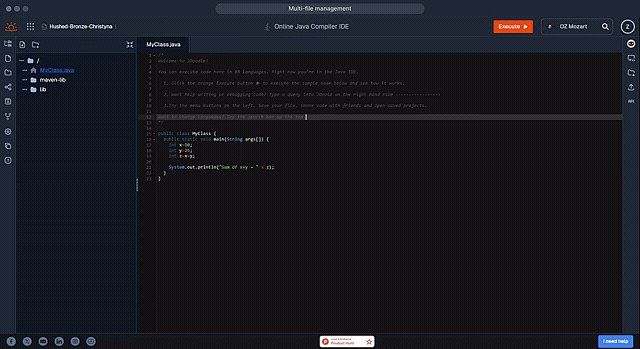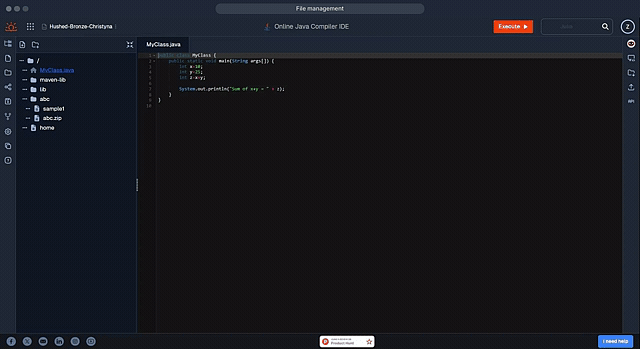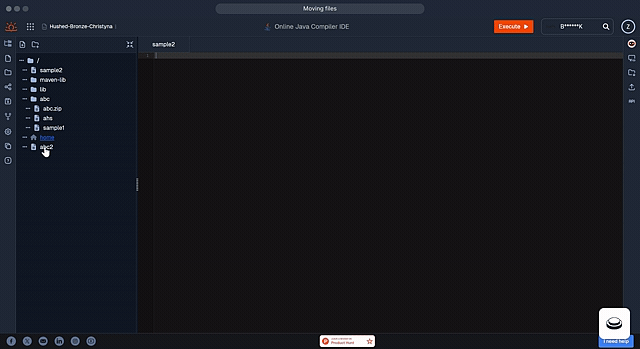Multi-file execution
Run multiple files together in 20+ languages.
The Multi-file IDE offers a comprehensive environment for easily managing your project’s files and folders.
Tree component
The tree component displays your project’s directory structure in a hierarchical format, allowing you to navigate through folders and files easily.
Features
- Add new files and directories to keep your project organized.
- Change the names of existing files and folders as needed.
- Delete unwanted files and folders from your project.
- Easily move files and folders by dragging them to your desired location within the tree.
- Upload files directly into specific folders for streamlined management.
- Download individual files or entire folders as ZIP archives for convenient access.
Managing folders
Create, rename, delete, and upload folders. 
Creating a new folder
- Right-click on an existing folder in the tree or use the context menu.
- Select “New Folder”.
- Enter the folder name and press Enter.
Creating a new file in a folder
- Right-click on the target folder.
- Select “New File ”.
- Enter the file name with the appropriate extension (e.g., main.js, index.html) and press Enter.
Deleting a folder
- Right-click on the folder you wish to delete.
- Select “Delete Folder ”.
- Confirm the deletion when prompted. Note: Deleting a folder will remove all its contents, including subfolders and files.
Renaming a folder
- Right-click on the folder.
- Select “Rename Folder ”.
- Enter the new folder name and press Enter.
Uploading files to a folder
- Right-click on the target folder.
- Select “Upload File ”.
- Choose the file(s) from your local machine to upload.
Downloading a folder
- Right-click on the folder you wish to download.
- Select “Download Folder ”.
- The folder and its entire contents will be downloaded as a ZIP file.
Managing files
Set the home file, delete, rename, and download files. 
Setting a Home (Start) file
The home file is the entry point for your project during execution.
- Right-click on the file you want to set as the home file.
- Select “Set as Home File ”.
- The selected file will be marked as the starting point for execution. Note: Only one file can be set as the home file at a time.
Deleting a file
- Right-click on the file you wish to delete.
- Select “Delete File ”.
- Confirm the deletion when prompted.
Renaming a File
- Right-click on the file.
- Select “Rename File ”.
- Enter the new file name (including the extension) and press Enter.
Downloading a file
- Right-click on the file you wish to download.
- Select “Download File ”.
- The file will be downloaded to your local machine.
Moving files and folders
 You can reorganize your project structure by moving files and folders:
You can reorganize your project structure by moving files and folders:
- Click and Hold on the file or folder you want to move.
- Drag it to the desired location within the tree.
- Release the mouse button to drop it into place.
Tips:
- You can move items into folders or reorder them within the same directory.
- The tree will expand automatically when you hover over a collapsed folder.
Execution
For languages that support complex project configurations, such as Java , C++ , and Python , the IDE provides robust tools to manage and execute multi-file projects.
- Organize your codebase with multiple files and classes, allowing for modular and maintainable code.
- Compile and execute projects with numerous interconnected files, handling dependencies automatically.
- Access advanced functionalities tailored to each programming language, including debugging tools, build configurations, and integration with language-specific libraries.
For executing code in Frameworks, check this documentation.
Supported languages
Here are the list of languages that support multi-file execution.
- Java
- HTML/CSS/JavaScript
- C
- C99
- C++/C++ 14/C++ 17
- Bash
- Free Basic
- Typescript
- Python2/Python2
- C#
- PHP
- Node.js
- Ruby
- Perl
- Scala
- Swift
- Kotlin
- R
- Lua
- COBOL
- Dart
- Groovy
- Verilog
Additional tips
- Always use the correct file extensions to ensure proper syntax highlighting and compilation. For example, use .js for JavaScript files, .py for Python files, etc.
- Setting the correct home file is crucial for successful execution, especially in multi-file projects with unclear entry points.
- Manage and include any dependencies your project requires and verify they’re installed and referenced, especially when working with frameworks.
- Ensure all files are saved, and the code is syntax errors-free.
